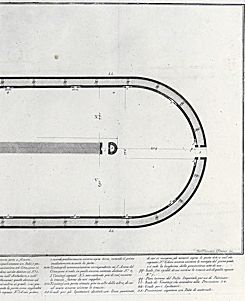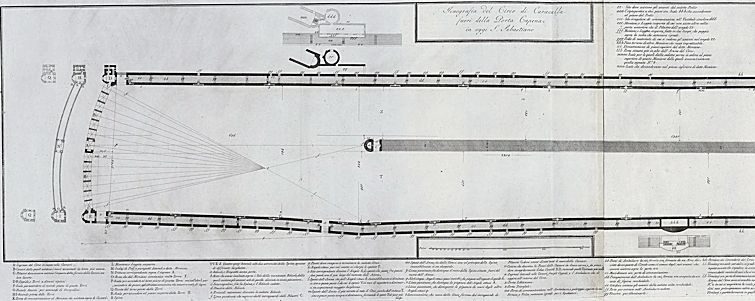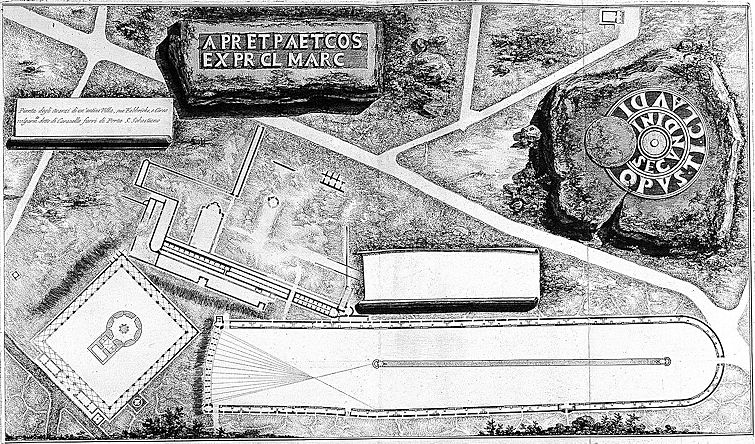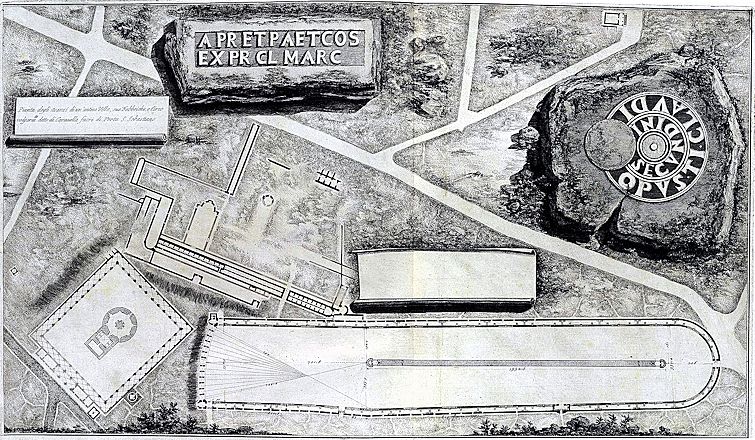
Top: Francesco Piranesi, 'Icnografia del Circo de Caracalla fuori della Porta Capena in oggi S. Sebastiano' in Opere varie (Getty Research Institute), circa 1786. Middle: Giovanni Battista Piranesi (attributed), 'Pianta degli avanzi di un 'antica Villa, sue Fabbriche, e Circo volgarmente detto di Caracalla fuori di porta S. Sebastiano' first state, circa 1778 in Le Antichitą Romane vol. 1 (Universitätsbibliothek Heidelberg), 1787. Bottom: Giovanni Battista Piranesi (attributed), 'Pianta degli avanzi di un 'antica Villa, sue Fabbriche, e Circo volgarmente detto di Caracalla fuori di porta S. Sebastiano' second state, dimensions added, 1778 in Le Antichitą Romane vol. 1 (Getty Research Institute), 1787.
4. The author discovered two states of 'Pianta dell antico Foro Romano' online 27 December 2019. A first state printing of the Roman Forum plan exists within the University of Cologne copy of Le Antichitą Romane vol. 1. A second state printing of the Roman Forum plan exists within the University of Tokyo copy of Le Antichitą Romane vol. 1.
5. The author discovered two states of 'Ichnographia Campus Martius' at the Fine Arts Library of the Univesity of Pennsylvania 14 May 1999. A first state printing of the Campo Marzio plan exists within the University of Pennsylvania copy of Il Campo Marzio dell'Antica Roma. A second state printing of the Campo Marzio plan exists within the University of Tokyo copy of Il Campo Marzio dell'Antica Roma
6. https://en.wikipedia.org/wiki/Roman_circus, accessed 13 June 2022.
| |
9 November 1778. Francesco's 1786 plan appears within a volume of his Opera varie, and the two versions of the unsigned circus site plan appear separately as addendums within post-1787 editions of Le Antichitą Romane vol. 1, along with two plans of the Palatine hill's Palace of the Caesars signed by Francesco, 1787. Complications already in abundance, but at least we know that all three plans depict what Piranesi considered "curious and interesting work."
The completeness of Francesco's data-full circus plan strongly suggests the culmination of extensive field survey work carried out to record every possible accuracy. The two unsigned circus site plans likewise exhibit accuracy as to the correct positioning and geometry of the discernable ruins throughout the site, which also suggests the culmination of extensive field survey work, yet at the same time the two unsigned drawings register incompleteness, if not also obscurity. And in terms of inaccuracy, the only real fault of all three plans is their identification as the Circus of Caracalla (emperor from 198 to 217); the correct identification of the Circus of Maxentius (emperor from 306 to 312) did not occur until the second quarter of the nineteenth century.
The first questions raised by the two near identical circus site plans are, "Who drew them and why did Francesco append them to Le Antichitą Romane vol. 1?" It seems doubtful that Francesco would add any plate to Le Antichitą Romane that was not the product of his father or himself, and, if Francesco were the person responsible for the site plans, he would have signed them as such. Thus, given Piranesi's expressed curiosity and interest in the depicted circus, it is then perfectly reasonable to attribute the site plans to Piranesi himself. And, with the attribution of Piranesi as the person responsible for this pair of site plans, the incompleteness and obscurity of the overall composition of the etching becomes much less inscrutable.
The undeniably intentional asymmetry of the Circus of Caracalla [sic] plan undoubtedly surprised Piranesi the most. Prior to this plan every other Piranesi-drawn ancient circus plan is strictly symmetrical for the whole length of the circus--see the Circus Maximus within the 'Pianta dell antico Foro Romano' first state4 in Le Antichitą Romane Vol. 1 (1756) and the Circus Agonalis sive Alexandri, Circus Apollinaris, Circus Caii et Neronis, Circus Domitiae, Circus Flaminius jam tum Apollinaris, and Circus Hadriani within the 'Ichnographia Campus Martius' first state5 in Il Campo Marzio dell'Antica Roma (1762). Although it is difficult to assert with any certainty, Piranesi nevertheless may well be the first person in modern times to discovery that "the carceres, or starting gates, had a distinctive, slanted, slightly curved, plan form, designed to compensate for what would otherwise be significant differences in the distances from the individual starting gates to the start of the first section of straight track on the right hand side of the spina (as seen from the carceres)."6 In any case, the asymmetrical form-follows-function design of the Circus of Caracalla was certainly new to Piranesi, as he meticulously delineated the geometry of the race-starting-formula within the Circus of Caracalla plan, and, subsequently, decided to redraw and correctly redesign all the circuses he had already drawn within the 'Pianta dell antico Foro Romano' and the 'Ichnographia Campus Martius.' The new intelligence Piranesi gathered at the Circus of Caracalla
|



